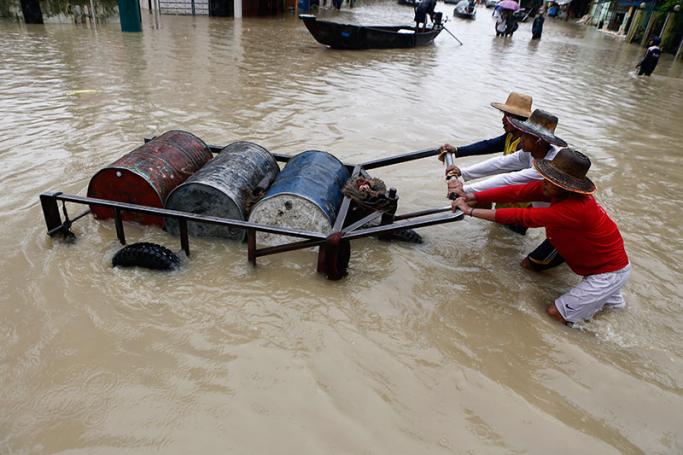The increase in frequency of natural disasters such as cyclones, flooding, and extreme temperatures like El Nino in Myanmar, is a sounding alarm that climate change’s impacts on the country cannot be ignored. In fact, the consequences of climate change are predicted to hit the South and Southeast Asia Regions of the world the hardest, considering their locations in low-lying coastal areas and in the tropical storm areas. For the states in these regions, such as Myanmar, Bangladesh, and India, they are already facing, and will be facing social consequences of climate change such as scarcity in resources, and political impacts due to ecomigration resulting from climate change. Climate change can lead to ecomigration from the region with scarcity in resources, to region with more resources.
Compared to its neighbouring countries India and Bangladesh, Myanmar has more resources in terms of land and freshwater per capita. With India (population of 1.311 billion as of 2015) and Bangladesh (population of 161 million as of 2015), being among the top most populous nations of the world, there are possibilities that the added pressure of climate change’s consequences on the existing limited water and food resources for their populous, could force the citizens, especially from Bangladesh to migrate towards neighbouring India, and Myanmar. In the past, there had been migration from Bangladesh into India’s state of Assam and political tensions among the immigrants as well as the receiving populous had occurred. The previous political tensions as well as the lack of resources per capita available in India, could render the ecomigrants to move onto Myanmar.
However, despite its abundance of resources per capita compared to India and Bangladesh, Myanmar also has limited resources for its populous and climate change’s irregular weather patterns such as El Nino as well as the increase in occurrences of natural disasters, can affect food production as well as the availability of fresh water resources. This means that accommodating ecomigrants into the country could be a burden for Myanmar, especially in terms of resources.
Nevertheless, climate change transcends national boundaries, and its social and political effects can spill over. Thus, it is essential for governments of these three countries to cooperate in terms of sharing water resources as water boundaries span national boundaries whilst at the same time, to find and enforce sustainable means to achieve water and food securities within each country. Additionally, a dialogue on how to deal with potential ecomigration as well as to prevent the social and political conflicts that could arise from climate change is essential amongst the three countries.
For Myanmar, one possible coping mechanism towards ecomigration would be to seek help from wealthier nations and international donors in terms of economic assistance if Myanmar provides for the ecomigrants from Bangladesh. This method could relieve the economic strain Myanmar could face due to sharing of resources between the existing in-country population and the migrant population, whilst providing ecomigrants with a place to resettle to.
Myanmar also has to implement internal climate change mitigation policies to address the potential social and political impacts of climate change. Currently, Myanmar does not have a National Climate Change Strategy in place but it is in the process of adopting it in 2016 (McKinley et al., 2015).The previous government had issued Myanmar’s National Adaptation Programme of Action (NAPA) to climate change in 2012 (McKinley et al., 2015). This plan focuses on making communities resilient to climate change by emphasizing on producing climate resilient agriculture, and reforestation. The plan also proposes implementing early warning systems to better inform the citizens about imminent disasters. At the same time, it is equally important that the current government makes it a priority to come up with preventative measures to natural disasters rather than responding only when natural disasters strike.
A nation-wide umbrella study which encompasses each state and region’s vulnerability and risks to climate change impacts should be assessed. This would give a thorough understanding of the kinds of natural disasters that are frequent in specific regions and states and what should be done to prevent and mitigate consequences. Myanmar has five different geographic regions: Hilly, Delta, Dry Zone, Coastal, and Plain- so regional assessments should be carried out for each region because impacts of climate change on each region could vary. A vulnerability study, and customized emergency response plan should be conducted for each geographic region, prior to developing climate change preventative measures. Periodical scenario-based exercises should be conducted in order to ensure that plans are appropriate for each kind of threat posed by climate change in each geographic region. More importantly, the government has to ensure policies are implemented at each level so as to prepare ahead for the potential social and political consequences of climate change in Myanmar.
T Nang Seng Pan is a researcher at Myanmar Institute of Strategic and International Studies (MISIS). She holds a BA in International Studies (May 2015), from Juniata College, USA. She has worked on research papers on topics such as public health, identity, development and climate change. She is also a Project Officer at Innovations for Poverty (IPA), Myanmar. The views expressed in this article are her own. Her research paper on “Assessing the Impact of Climate Change and its Potential Social and Political Implications for Bangladesh, India, and Myanmar.” has been published online by the Myanmar Institute of Strategic and International Studies as part of a collaborating project by MISIS and the Norwegian Institution of International Affairs. The paper can be accessed through www.myanmarisis.org.
You are viewing the old site.
Please update your bookmark to https://eng.mizzima.com.
Mizzima Weekly Magazine Issue...
14 December 2023
Spring Revolution Daily News f...
13 December 2023
New UK Burma sanctions welcome...
13 December 2023
Spring Revolution Daily News f...
12 December 2023
Spring Revolution Daily News f...
11 December 2023
Spring Revolution Daily News f...
08 December 2023
Spring Revolution Daily News f...
07 December 2023
Diaspora journalists increasin...
07 December 2023
Landslides kill 12 as monsoon batters refugee camps












